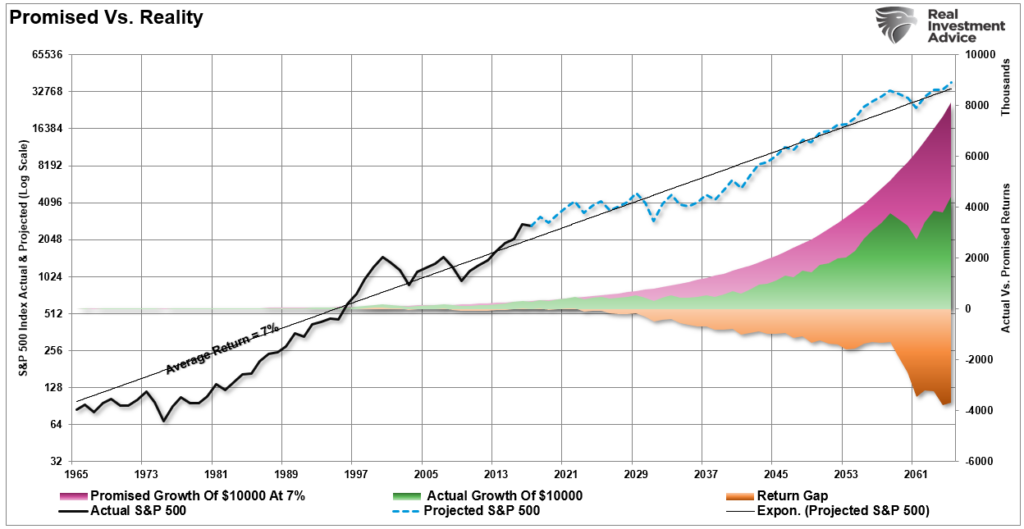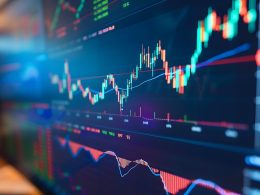by Lance Roberts, RIA
When markets decline—especially after long periods of sustained growth—the familiar advice resurfaces: “Be patient. Stay invested. Ride it out.” The rationale? The market always goes up over time. But there’s a critical flaw in this narrative.
Your portfolio and a portfolio benchmark are entirely different things.
And portfolio benchmarking, or the constant comparison of your performance to major indices like the S&P 500, can be dangerously misleading for real-world investors. Here’s why.
1) Markets Do Not Compound Returns
One of the most critical fallacies of portfolio benchmarking is the disparity between compound and variable rates of return. To wit:
While the average rate of return may have been 10% over the long term, the markets do not deliver 10% every year. Let’s assume an investor wants to compound their returns by 10% annually over 5 years. We can do some basic math.

After three straight years of 10% returns, a drawdown of just 10% cuts the average annual compound growth rate by 50%. Furthermore, it then requires a 30% return to regain the average rate of return required.
There is a significant difference between average and actual returns. The impact of losses destroys money’s annualized “compounding” effect.
To prove that, the purple shaded area shows the “average” return of 7% annually. However, the differential between the promised and “actual return” is the return gap. See the problem?

The differential between what investors were promised (and a critical flaw in financial planning) and actual returns is substantial over the long term.
“When imputing volatility into returns, the differential between what investors were promised (and this is a huge flaw in financial planning) and what actually happened to their money is substantial over the long-term.
The second point, and probably most important, is that YOU DIED long before you realized the long-term average rate of return.”
Most importantly, as noted above, the concept of “TIME” is critical to the investing equation. While 10% annualized returns sound fantastic, those were over 100 years and included an average dividend yield of almost 4%. Unfortunately, you will not live long enough to realize those “average rates of return.” Furthermore, the current dividend yield is less than 2%.
However, the stark differences between a portfolio benchmark and an actual portfolio of individual equities are even more important than the concept of time.
Building The Sample Portfolio Benchmark
For this discussion, we need to build a sample portfolio benchmark. This Sample Index comprises five fictional companies, but it works just as well as an index of 500 companies. For this purpose, each company has 1000 shares of stock outstanding, and all trade at $10 per share. The table below shows the index versus “Your Portfolio,” a $50,000 investment weighted the same as the portfolio benchmark. I have also labeled each of the six following examples as year 1, 2, etc., so we can calculate the performance at the end of this discussion.
In Year 1, our starting point, we divide a $50,000 investment into the same weights and stocks as the Sample Index as follows:

There are a couple of caveats here.
- Using so few stocks amplifies the percentage changes to the index and, subsequently, the portfolio.
- Outside of the examples covered here, many other factors significantly impact performance. Events such as mergers, buyouts, and acquisitions affect the index.
- Unlike a portfolio benchmark, your portfolio is impacted by withdrawals and contributions.
- The example assumes no dividends, which would change portfolio performance.
- Most importantly, taxes and fees significantly impact portfolio performance and are excluded as they do not exist in portfolio benchmarks.
The last factor alone accounts for the bulk of the long-term underperformance but is often ignored by investors.
However, this is only for informational and learning purposes; it is the concept we are after.
The Status Quo
In the second year of our example, we assume nothing exceptional, other than normal price appreciation or depreciation. The table below shows the impact of price changes on both the Sample Index and Your Portfolio.

Unsurprisingly, their performance is identical since price changes directly impact both the index and the portfolio. However, in the real world, such a “stagnant” situation rarely exists over twelve months. Therefore, it is essential to understand the risk that volatility plays in portfolio outcomes. Furthermore, other factors are “index benefits” that individual investors cannot access.
Since the last recession’s end, corporations have become major buyers of their own stock, pushing such actions to record levels. Wall Street analysts typically view stock buybacks as a good thing because they are a sign that the company believes in itself. However, nothing could be further from the truth.
The reality is that stock buybacks are a tool used to artificially inflate bottom-line earnings per share, ultimately driving share prices higher.
The importance of buybacks cannot be overlooked. The dollar amount of sales, or topline revenue, is complicated to fudge or manipulate. However, bottom-line earnings are regularly manipulated by accounting gimmickry, cost cutting, and share buybacks to enhance results, boost share prices, and meet “Wall Street Expectations.”
Let me show you a simple mathematical example. The first table and chart below show sales for a hypothetical company over 5 years. The sales are stagnant at $10,000 a year.
Look at what happens to sales/share and earnings/share as the outstanding stock amount reduces..
If you were only looking at the two charts, you would assume that this stock was growing strongly. In reality, growth was zero over those five years.
Let’s look at the same example, but this time, we will reduce the company’s sales and earnings while buying back stock.
Once again, looking only at the sales and earnings/share charts, the latter being the primary focus of Wall Street, investors would be lured into thinking that this was a strongly growing company. However, in reality, sales and earnings were deteriorating, masked by the reduction in outstanding shares. Stock buybacks DO NOT show faith in the company by the executives, but rather a LACK of better ideas for using capital.
Significantly, for our overall example, the reduction in outstanding shares ALSO reduces market capitalization.
Let’s go back to our original index and portfolio example.
In year 3, THREE events impacted the index and our portfolio.
- Company DEF buys back 50% of its outstanding shares
- Company MNO files for bankruptcy.
- Each company experiences a change in share price.
The table below shows the impact of these three events on the index and the portfolio.

Notice that the share buyback and the bankruptcy combined caused the index’s market capitalization to collapse by almost 18%. However, the dollar loss to your portfolio is roughly only 9%.
This reduction in the market capitalization of Company DEF did nothing to change the price or number of shares owned on a dollar basis in your portfolio. However, the collapse in the stock of Company MNO as it filed for bankruptcy resulted in a significant loss of investor principal.
4) Substitution Effect
This brings us to the “substitution effect.” Investors chided for chasing the financial markets at their peril rarely discuss this issue.
When a company, such as GM, AIG, Enron, Worldcom, and many others in history, goes bankrupt, it is swapped out of the index for another company. The index is then reweighted for the “substitution.” The table below shows the impact of the substitution on the index and your portfolio.

The substitution immediately boosts the index due to the boost in market capitalization. However, your personal investment portfolio does not see such a positive effect. On a dollar-weighted basis, the bankrupt company still affects the total portfolio’s value.
To align your portfolio with the Sample Index, you must sell MNO Company’s stock and replace it with PQR.
That brings us to the final step, the “replacement effect.”
5) The Replacement Effect
A problem arises when replacing a stock in your actual portfolio. Since there is no cash in the portfolio other than what was raised by the sale of MNO, only 100 shares of PQR can be purchased, as shown in the table below.
As with each year previously, I have also included price changes for each company other than PQR so that the substitution and replacement were done at the same price for example purposes.

Note: Yes, I could have rebalanced the portfolio to raise cash to purchase more shares of PQR, however, we have NOT rebalanced the index. Therefore, using just available cash is the appropriate measure.
If you look at the Year 4 table above, you will see that the index and your portfolio declined by $1000 between years 4 and 5. However, the index’s decline was -2.7% versus only -1.96% for your portfolio. That is specifically because your portfolio is $4000 less than the index.
Your Portfolio Is Vastly Different
Comparing your performance with an index is the most useless and potentially dangerous thing you can do as an investor.
Stock buybacks, the “substitution effect,” taxes, expenses, and fees contribute to the index’s underperformance. Repeated studies have shown that roughly only 1 in 4 mutual fund managers outperform the market index over long periods. Of those outperforming, the average outperformance was just .12% before fees and expenses. However, the costs and expenses were larger than the level of outperformance. That, of course, does not include the tax impact on gains and income.
The problem with chasing performance is that once you fall behind, you take on more risk to try to make up the difference. Ultimately, this leads to more costly outcomes in the future, compounding the underperformance.
The primary learning points regarding the fallacy of chasing a “benchmark index” are:
1) The index contains no cash
2) It has no life expectancy requirements – but you do.
3) It does not have to compensate for distributions to meet living requirements – but you do.
4) It requires you to take on excess risk (potential for loss) in order to obtain equivalent performance – this is fine on the way up, but not on the way down.
5) It has no taxes, costs or other expenses associated with it – but you do.
6) It has the ability to substitute at no penalty – but you don’t.
7) It benefits from share buybacks – but you don’t.
Investors should consider building portfolios around what matters most to winning the long-term investing game.
– Capital preservation
– A rate of return sufficient to keep pace with the rate of inflation.
– Expectations based on realistic objectives. (The market does not compound at 8%, 6% or 4%)
– Higher rates of return require an exponential increase in the underlying risk profile. This tends to not work out well.
– You can replace lost capital – but you can’t replace lost time. Time is a precious commodity that you cannot afford to waste.
– Portfolios are time-frame specific. If you have a 5-years to retirement but build a portfolio with a 20-year time horizon (taking on more risk) the results will likely be disastrous.
The index is a mythical creature, like the Unicorn, and chasing it takes your focus off what is most important – your money and your specific goals. Investing is not a competition, and there are horrid consequences for treating it as such.
Just something to think about in the current market environment.
Copyright © RIA














